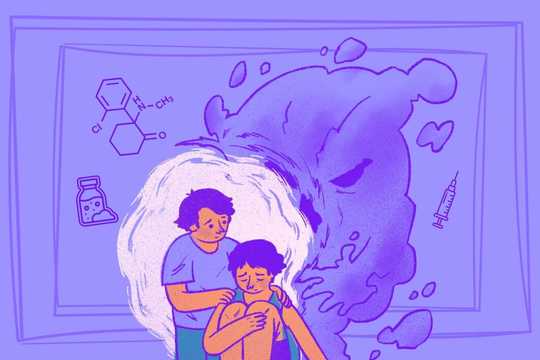Most of us understand the “fight or flight” response. When there is a threat, you either confront it with your fists or run away. But have you heard of the “freeze” response? This article explores the polyvagal theory and its connection to psychedelic therapy. We spoke with Dr. Erica Zelfand for her expert insight.
What’s happening in your body influences how you think and feel.
— Dr. Erica Zelfand
Dr. Erica Zelfand is licensed as a family medicine doctor — also known as a primary care provider (PCP) or a general practitioner (GP). Training in primary care entails knowing about a variety of health conditions affecting different parts of the body and mind. She specializes in integrative mental health and functional medicine.
Dr. Zelfand graduated from one of the world’s only few accredited naturopathic medical schools. She has expertise and experience in nutrition, supplements, botanicals (herbs), functional medicine, orthomolecular medicine, lifestyle counseling, bodywork, and mental health.
In addition to treating patients of all ages in her private practice, Dr. Zelfand is a ketamine prescriber, facilitator of therapeutic psychedelic experiences, trainer of psychedelic facilitators, acclaimed international speaker, and medical writer. She often presents at medical conferences on the clinical applications of psychedelic healing.
Dr. Zelfand teaches internationally in psychedelic medicine. She is an advocate for the normalization and legalization of entheogens. She is committed to the cause of making medicines like psilocybin, MDMA, and ketamine accessible to others. Additionally, she is the founder of the nonprofit organization Right to Heal.
Stumbling Into Psychedelic Medicines
When Dr. Zelfand went into healthcare, it was not her original plan to become an expert in psychedelic therapy. But then she opened a primary care practice in a suburb of Portland, Oregon. She realized a staggering percentage of her patients had mood and mental health issues.
It gives us one more toolkit for understanding why these drugs are so incredible.
— Dr. Erica Zelfand
She explained that primary care providers end up carrying quite a bit of that load due to the stigmatization of mental health issues and limitations of the healthcare system. And that was something she did not expect when she went into practice.
Her Toolkit Was Lacking a Certain Something
Dr. Zelfand essentially had to train herself on how to be a psychiatrist in integrative and functional medicine. While practicing, she had more than the psychiatry drugs in her toolkit, such as herbal medicine and orthomolecular nutrition. However, she still didn’t feel fully equipped to treat her patients.
“[I] felt like I wasn’t really able to successfully crack a lot of the cases of even just run-of-the-mill depression that I was seeing. And it was very clear to me that I needed more tools and more robust tools,” explained Dr. Zelfand.
She went to conferences on mental health and learned about genomics. But it didn’t give her what she was looking for.
A Personal Quest Turns Into a Professional Revelation
Dr. Zelfand found herself in an ayahuasca ceremony for personal reasons. She didn’t think that there would ever be an overlap between this personal quest and her professional development.
However, within an hour of taking her first cup of ayahuasca, she had a revelation.
“I realized I needed to understand the science of how this works. And then it was an eventual process before I came out of the psychedelic closet and started talking about this professionally,” shared Dr. Zelfand.
The Truth Behind the Connection Between Your Mind and Body
Most people believe that what we think in our minds determines how we feel in our bodies. That’s true, but Dr. Zelfand shared that it’s only a very small piece of the truth.
She explained that an even stronger truth is that what’s happening in your body influences what’s going on in your mind. Then, depending on your thoughts and feelings, that becomes a vicious cycle.
“The polyvagal theory is one theory that helps us to better understand and appreciate the ways in which physiology influences psychology…[which means] what’s happening in your body influences how you think and feel,” explains Dr. Zelfand.
What is Polyvagal Theory?
Dr. Stephen Porges developed Polyvagal Theory in the 1990s. It provides a nuanced understanding of the human autonomic nervous system and its role in regulating emotional and social behavior.
It builds on the traditional view of the autonomic nervous system, which comprises the sympathetic nervous system (“fight or flight” response) and the parasympathetic nervous system (rest and digest).
Polyvagal Theory introduces a third type of nervous system response called the social engagement system, which is part of the parasympathetic nervous system.
Understanding the Physiology to Understand the Psychology: The Vagus Nerve
Dr. Zelfand first talked about the physiology of the vagus nerve to help explain the Polyvagal Theory.
There is a very long nerve in the body called the vagus nerve. It travels from the brain to many other parts of the body. It’s called vagus—like the word vagrant—because it wanders. It goes everywhere: to the throat, where it regulates our swallowing, to the heart, lungs, and digestive tract.
The vagus nerve is like a superhighway connecting the brain to many organs in our bodies. Most people think that nerves go from the brain to the body. This direction is how the brain tells the body to move or perform certain functions, and that’s true.
However, in the case of the vagus nerve, only about 10% of the fibers go from the brain to the body. The remaining 90% of the nerves go the other way. They go from the body up to the brain.
“So if you picture the vagus nerve as a 10-lane highway. Only one of the lanes runs north to south. The remaining nine lanes run south to north. This is the reality of the vagus nerve. Experiments have been done to test that. All this stuff is going to the brain,” explained Dr. Zelfand.
The physiology of the vagus nerve tells us that the things happening in the body significantly influence what’s happening in the brain. This physiology also forms the basis for the gut-brain axis, which emphasizes how the foods you eat impact the health of your brain.
The theory posits that the autonomic nervous system is hierarchical and operates through three primary states.
The Ventral Vagal Complex (Social Engagement System)
Dr. Zelfand explained that polyvagal theory suggests that there are two branches of the vagus nerve. The ventral vagus nerve is located in front of the body. This branch is thought to be the newer one.
The ventral vagal complex, or social engagement system, is associated with feelings of safety and calmness. It allows for social engagement and connectedness. When this system is active, individuals are more likely to engage in social behaviors, communicate effectively, and build connections with others.
The Sympathetic Nervous System (Fight or Flight)
When a threat is perceived, the sympathetic nervous system activates, preparing the body to either fight the threat or flee from it. This response is characterized by increased heart rate, rapid breathing, and heightened alertness.
The Dorsal Vagal Complex (Freeze or Shutdown)
The older branch of the vagus nerve is called the dorsal vagus nerve. Dr. Zelfand explained that it’s older in the sense that it’s been with living species for longer. It’s more of a reptilian brain response.
In situations of overwhelming threat where “fight or flight” is not possible, our bodies can respond in a third response called the “freeze” response. The dorsal vagus nerve mediates this response. This mediation can manifest as dissociation, numbness, or a sense of immobility.
Dr. Zelfand explained that the “freeze” response is thought of as a more severe response. She gave the example of a gazelle being chased by a tiger. The gazelle has no fighting chance. If it cannot outrun the tiger, the only other choice is to freeze and play dead. That is the work of Stephen Porges.
Rape Victims and The “Freeze” Response
Dr. Zelfand spoke about how understanding the “freeze” response has improved the legal system. She gave a case example of when someone has been raped and the argument that occurs when it ends up in court. The defense would argue that the victim didn’t say no and fight back and just laid there. This argument has often been used to gaslight victims and make them feel like they had done something wrong.
“[W]ith the polyvagal theory, we now understand that it is a very biological and very natural response [for rape victims] to freeze and play dead because that is how deep the threat is perceived by the nervous system,” explained Dr. Zelfand.
Dive Deeper Into Polyvagal Theory (And More!) From Dr. Erica Zelfand:
- Enroll in Dr. Erica Zelfand’s Comprehensive Course on Polyvagal Theory & Healing the Mind
- Discover Which Supplements Reduce the Side Effects of MDMA or Ecstasy
- Is Microdosing for Depression Better Than Conventional Treatments? Find Out Here
- Explore These Simple Ways to Get the Most Out of Every Ketamine Treatment
- Learn Why We Need to Acknowledge That Bad Trips Exist: Here’s How to Work With Them
The Polyvagal Theory and Trauma
Polyvagal Theory emphasizes the importance of the body’s physiological state in influencing and being influenced by emotional and psychological experiences. It has significant implications for understanding stress, trauma, and emotional regulation.
The theory suggests that fostering a state of safety and social connection can help activate the social engagement system, thereby supporting healing and recovery from trauma and enhancing overall well-being.
Dr. Zelfand shared that the dorsal vagus nerve and the “freeze” response don’t get enough credit when we talk about the effect of trauma on the body and the nervous system. Many people don’t fight or run when they feel activated. Instead, they freeze.
“When we look at how the body informs how we feel and think, we can really understand what happens when we are in an activated state of perceiving a threat. Our brains will scan the environment, and they will selectively view things that could be a threat. And it becomes this negative spiral,” explained Dr. Zelfand.
For example, when we perceive a threat, and our nervous system gets activated, we might also be unable to hear mid-range frequencies. We’re able to hear the higher ranges, like screams, and lower ranges, like animal growls. If we’re triggered in an environment where most of what’s happening is mid-range frequencies, we won’t be able to hear the things that reassure us of safety.
Essentially, when we feel a threat, we will perceive more evidence of the threat. Then, we will continue to stay in that nervous system state of feeling threatened.
The Role of Polyvagal Theory in Psychedelic Therapy
Dr. Zelfand explained that understanding the “freeze” response helps people give themselves a bit of a break. They beat themselves up less. Also, care providers can better understand how to support our patients. If we understand Polyvagal Theory, the things we witness or experience ourselves when we take psychedelics will make a lot more sense.
Follow your Curiosity
Sign up to receive our free psychedelic courses, 45 page eBook, and special offers delivered to your inbox.For example, one of the easiest and cheapest ways to stimulate the vagus nerve is with deep breaths. Another way is through humming or singing. We often see the depth and quality of breathing changing in those in psychedelic states. We might also hear people humming, moaning, or singing more. In addition, singing is a huge element in group ceremonies. All of this occurs naturally.
Shaking During Psychedelic States
Another thing that happens during psychedelic states is spontaneous shaking and tremoring. This is where the work of Stephen Porges dovetails into the work of Dr. Peter A. Levine, the author of Waking the Tiger.
Dr. Levine studied animals and the significance of shaking or tremoring in healing the trauma response. For example, the gazelle chased by a tiger plays dead and doesn’t get killed. The tiger goes away. But before it gets up and runs away, the gazelle shakes violently for a few minutes. Then, it stands up and prances away.
Animals, except humans, don’t have talk therapy. They don’t have a language-based or cognitively-based way of processing trauma. They only have their bodies. In nature, animals release trauma from their nervous systems through shaking.
Dr. Zelfand explained that we see this a lot when people enter psychedelic states where they may start to jerk, twitch, or tremble. It could be sometimes it’s uncontrollable. For instance, the client might say they can stop it if they want, but it takes effort.
She advises her clients not to stop it. This response is an important way in which their nervous system is equilibrating and coming back into harmony after weeks, months, or years of holding trauma in their system.
Read: Can Psychedelics Help Us Release Trauma Through Shaking?
“Having the understanding of Polyvagal Theory helps us to better appreciate the brilliance and self-healing response of the organism and of psychedelic medicines to align people with that healing mechanism. It gives us one more toolkit for understanding why these drugs are so incredible,” added Dr. Zelfand.
Ways to Help Calm Ourselves During Stress Based on Polyvagal Theory
We asked Dr. Zelfand how we could put the Polyvagal Theory into practice. She shared some simple tricks for calming ourselves during times of stress.
The polyvagal theory is one theory that helps us to better understand and appreciate the ways in which physiology influences psychology.
— Dr. Erica Zelfand
Activating the Vagus Nerve
The simplest way to activate the vagus nerve is through deep diaphragmatic breaths. Dr. Zelfand said these can be done at any rhythm since the expanding lungs massage the vagus nerve with every deep breath.
The pharyngeal branch of the vagus nerve is located in our throats. There are several ways to activate this branch that can help us calm our minds and bodies.
Other ways include the following:
- Humming
- Singing at mid-range, such as Disney songs and show tunes
- Laughing
- Gargling
Gut Healthy Diet
Dr. Zelfand explained that what happens in the gut directly informs what happens to the brain by way of the vagus nerve and other mechanisms. During times of stress, most people eat junk food. Eating junk food only perpetuates the stress. Stress begets more stress.
Therefore, it’s important to eat vegetables, fiber-rich foods, fermented foods, and probiotic foods. Dr. Zelfand explained that you don’t necessarily need to buy expensive probiotic supplements. While they may have some benefits, a lot can be done through food without having to buy pills or powders.
Watch Dr. Zelfand talk about Inflammation, Food, and Mood.
Mid-Intensity Movement
Dr. Zelfand emphasized that exercising regularly is important for mental health. However, despite the popularity of extreme workouts such as CrossFit and high-intensity interval training (HIIT), she recommends mid-intensity exercise.
She explained that we can assess vagal tone by heart rate variability. Heart rate variability is how easily your heart shifts in how fast or slow it beats. When you inhale, your heart speeds up a little bit. When you exhale, your heart rate slows down.
In terms of Polyvagal Theory and exercise, we would want to prioritize forms of exercise that will improve vagal tone and heart rate variability. Dr. Zelfand explained that the research has found that mid-intensity is the best.
She recommends doing jazzercise or going for a long bike ride over HIIT for someone with a dysregulated nervous system. Workouts such as CrossFit, where your heart works very hard, are stressful to the nervous system. Dr. Zelfand refers to it as warrior energy.
“When someone is post-trauma and healing a dysregulated nervous system, they don’t need to be a warrior. Sometimes, they just need to be a person swimming or doing regular movement,” explained Dr. Zelfand.
Learn More From Dr. Zelfand
- Support her non-profit organization: Right to Heal
- Take her courses:






